
Rendered Imperfectly Rendered Imperfectly
By MICHAEL GRAEVE
- View Michael Graeve's Biography
Michael Graeve is a sound and visual artist based in Castlemaine, Victoria, and a Senior Lecturer in the School of Art at RMIT University.
Rendered Imperfectly Rendered Imperfectly
By Michael Graeve
August 2019, Artist's statement from catalogue:
The moment of the space that was elsewhere becomes here quickly a profusion now. One becomes many. Links are broken, then awkwardly mended, thus imperfectly rendered. The question of representation. Those questions of representations. Crossings of sorts, too, falling into focus, or out of line, registering and deregistering. A relation, a-relation, a re-relation, a composite, an opposite, a plethora, a profusion, an allusion. Being located between spaces, in spaces, across spaces. Across purposes and across actions. It comes to hold a moment here only to evade us of the moment there.
Now we have a sequence of overlaps and overlays. Of delays and relays. Recordings from a gallery set in a semi-rural, semi-industrial location. A space filled with record players rumbling and tumbling, two dozen loudspeakers conjuring a complex mechanorganical surround in the interior. Thresholds between inside and outside, between artificial and natural, between technical and animal, between fake wood and real wind. Walk-throughs. Seatings and movings. All this, and more, now displaced to the Yarra Sculpture Gallery. Placed within earshot of traffic, with doublings-up of that traffic, and triangulated inside framings, with layers of angles. A rendering of moments and actions and dislocated spatial propositions.
May 2020, this text.
This text is an imperfect rendering of Rendered Imperfectly Rendered, which was created for Translating Ambiance, Yarra Sculpture Gallery, Collingwood Australia, 5-22 September, 2019, curated by Dr Jordan Lacey. If the spatial and sonic articulations were initially marked by proliferation and juxtaposition, then this text forms yet another.
One might listen to the linked sound documentation while reading the text. It features a 7'48" excerpt of a stereo-mix of a four-channel microphone recording which was recorded at ear-height as if seated on one of the chairs in the installation.
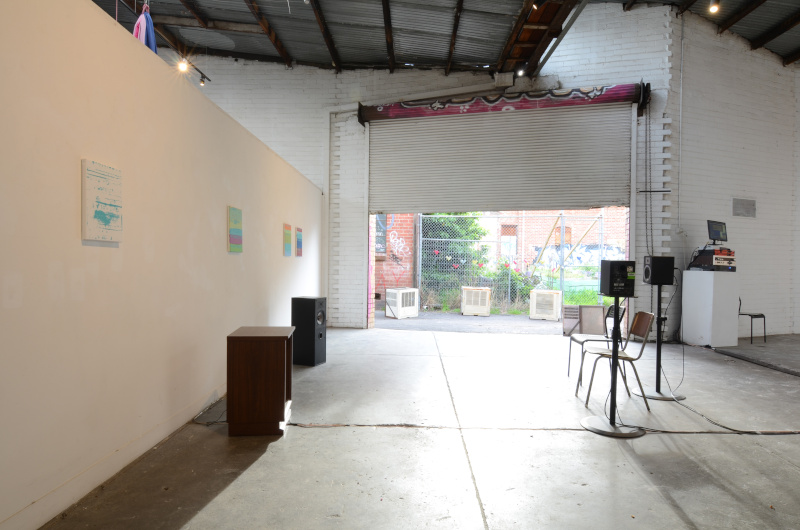
Rendered Imperfectly Rendered, Michael Graeve, 2019. Sound and painting installation, dimensions variable. 4-channel sound, 26 minutes, (stereo composition of field recordings, mono composition featuring voice reading, 1-channel live audio feed from shotgun microphone mounted outside the building). 2 mis-matched hifi loudspeakers, amplifier, 2 studio monitor loudspeakers, studio monitor stands, cables, computer. 4 Paintings (41 x 31cm, oil on linen). 2 chairs. Photograph by Michael Graeve, copyright.
Wilderness appeared in early conversations around the curation, before submerging as landscape, place and location. We know too well that nature is a construct: sitting over there, it is likewise open to suggestion, intranslatability, instability, untraceability. Still more tempting might be the power of the wild guess, the wild disjunction, the wild card. Viewpoints and hear-points that only hint at the complexity of location and space and experience and address that combine. All as markers of what we so idealise in nature: activity out of our control, embodied experience out of our depth.
Wilderness, wildness, now wild multiplicity. Parallel but asynchronous narratives, though still perfectly timed? Think only of the introduction to Lejaren Hiller's An Avalanche for Pitchman, Prima Donna, Player Piano, Percussionist and Pre-recorded Playback (1968) "...The audience isn't gonna understand much of what I've got to say tonight, but they're damn well going to hear it" (1970). It sure is the last moment that does make sense. Or a composition with just plain too much multiplicity, John Cage and Lejaren Hiller's HPSCHD (1967-1969).1 Or consider chance procedures here, but also the joy of surprise, jumpiness, incomprehension. Juxtaposition and multiple mono, as opposed to stereo, as in the early tape works by Kenneth Gaburo (2000), though there are so many more examples.2 Of not being able to put your finger on it. Multiple languages obscuring rather than revealing; nothing congealing. How not to capture it all in one essence, rather in multiple traces? How in turn to build from it, outwards? Additionally addressing multiple senses, representational schema. Imperfection, awkwardness. If there is then a quality to experience, it may well sit within complexity. I don't aim for aimless evasion, but I do worry about representation. And I find that for me uncertainty is disarming.
Or of language and word not ever adequate. There are few greater joys than the difficulty of defining a colour, forget even articulating it. I first heard readings of Ludwig Wittgenstein's Zettel (2007) composed into Ben.Harper's Wandering Split (2002). Doubt piled on doubt, how could we ever agree on the colour red? No wonder that last century so tantalisingly played with the death of the author and chance procedures. When presented parallel narratives, how do we not consider the one as a relation to the other? Not translate, even if we can, should? The point is that they never quite come into focus. A near-Bergsonian un-composite of experience and movement?3 Or the narration of the unnarratability of sound, as might have Alison Knowles in her Frijoles Canyon (1991)?
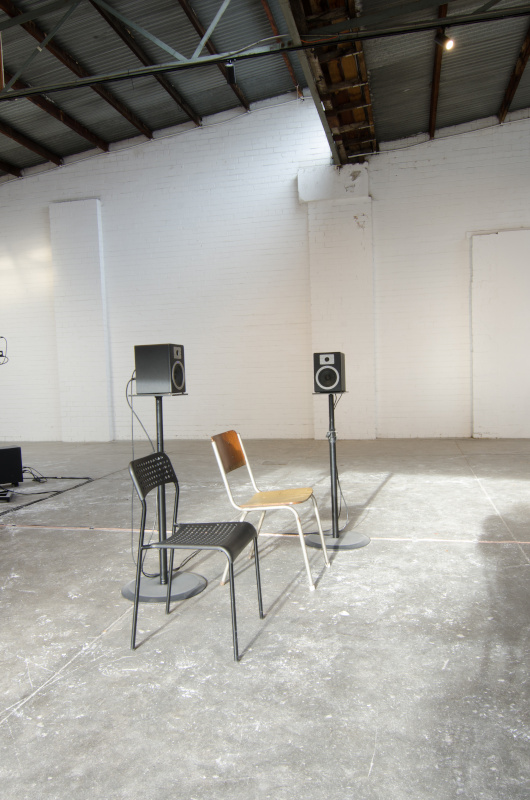
Rendered Imperfectly Rendered, Michael Graeve, 2019. Installation detail. Photograph by Michael Graeve, copyright.
Two chairs, alternative listenings already. The ambivalent centre of the new location was hinted at by the chairs, by that marker of a place from which to hear and view. The meeting point of experience -- deliberate confluence where the four loudspeaker projections and also the visual address collide.
One ear closer to the open roller door, from where radiated ambient sounds arrive, Collingwood sounds, traffic sounds. And, oddly, alpine sounds: recorded then filtered through Jordan Lacey's installation. One ear further from the outside, yet hearing the outside fed through a roof-mounted shotgun microphone, relayed, played through a studio monitor. Again the above-mentioned sounds, but modulated through microphone, cable, loudspeaker. False stereo. Crossings.4 Spatially a hard left and hard right, but audibly a doubling-up of directness and traces linking across. Or as David Grubbs (2000) sings:
IF YOU SAY "TWO SHADES OF GREEN"
DON'T FORGET THE SPECTRUM IN BETWEEN
CALL IT A FIRMAMENT; IT WAITS TO BE SEEN
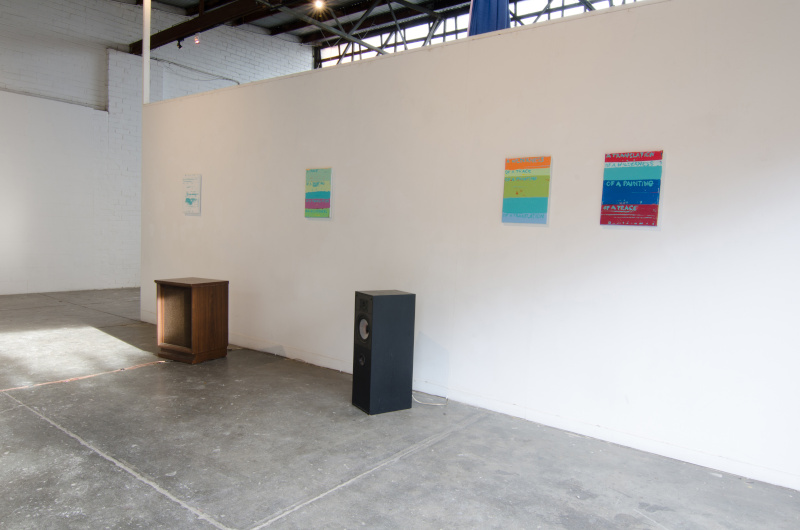
Rendered Imperfectly Rendered, Michael Graeve, 2019. Installation detail. Photograph by Michael Graeve, copyright.
Stereo recording. Stereo track. Played from two mis-matched loudspeakers, 70's and 90's vintage. Stereo image is a representation already, unpairing the loudspeakers increasing the fallacy of the perfect, always already a degenerate.5 Imaging, stereo spread, these are all terms representing reproduction, even construction. Even high fidelity. Fidelity to constructs. Addressing the seats. Had I set up my own ambiance? Walk-ins, walk-throughs, walk-outs, fluid movements of presence through an earlier sound and painting installation at Castlemaine's Lot19.6 Periurban, bush, birds, rain, white walls, wood floor, clusters of sound gear biting ankles. Translations of crossovers between a sound installation and surrounds. That representation repeated as trace in Collingwood.
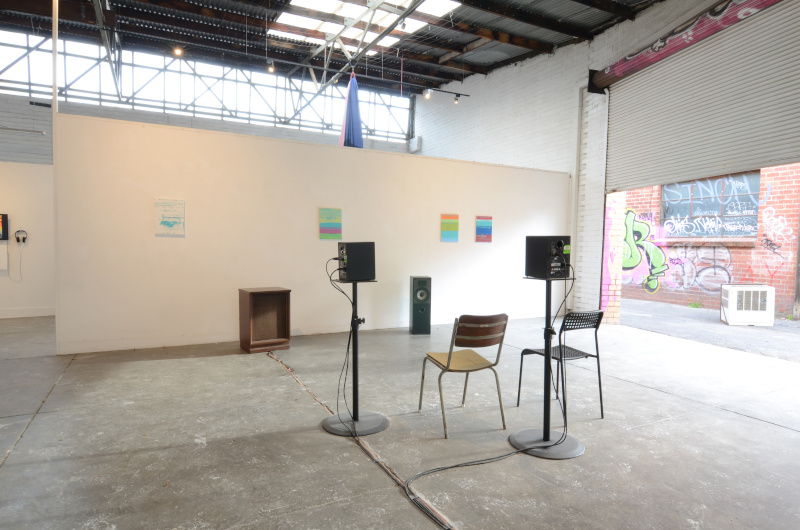
Rendered Imperfectly Rendered, Caption: Michael Graeve, 2019. Installation detail. Photograph by Michael Graeve, copyright.
In turn 4 paintings. Three partly-finished paintings, four stripes done, gain each in turn one last turquoise stripe, plus the wordings. Sound always somewhat invisible, drawn into the surface, drawn into the colour. A fourth painting captures a trace of all of them (layered now, and mirrored now of course). The text "of a sound" is nearly invisible, carving only a contour into the glitchy surface. And then a painting which has touched all of them, thus reversed, tripled-up, removing the ridges and contours of the others. I was initially surprised by the request for paintings, given the brief, but hasn't painting for such a long time haunted the picturesque?
A TRACE
OF A PAINTING
OF A SOUND
OF A TRANSLATION
OF A WILDERNESS
A WILDERNESS
OF A TRACE
OF A PAINTING
OF A SOUND
OF A TRANSLATION
A TRANSLATION
OF A WILDERNESS
OF A SOUND
OF A PAINTING
OF A TRACE
The wordings don't point to individual concepts so much as respective encapsulations. One within another. One after another. One relative to another. If it were a lens, the lens elements wouldn't work in consort. Out of focus, out of sync, out of line, out of shared purpose. A concrete formalist poetry -- all 120 possible variations implied. Are such potential variations sufficient? What acts on what? What acts on what in which sequence? Where to start and where to stop. If there were punctuation, where would it be? And if a flow of words, where to take a breath? The memories of before and the expectations of next, each trace a new relation.
Translation as most dynamically thrown into contrast when we experience how each part is subject to varied purpose and relation.
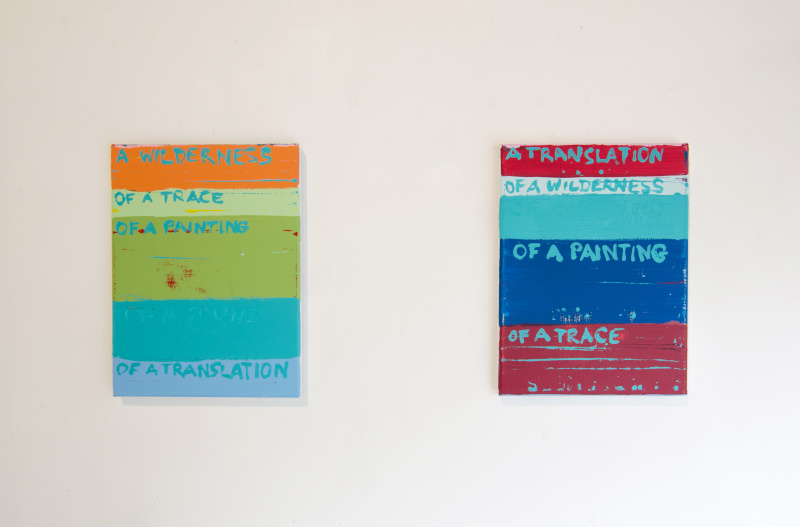
Rendered Imperfectly Rendered, Michael Graeve, 2019. Installation detail. Photograph by Michael Graeve, copyright.
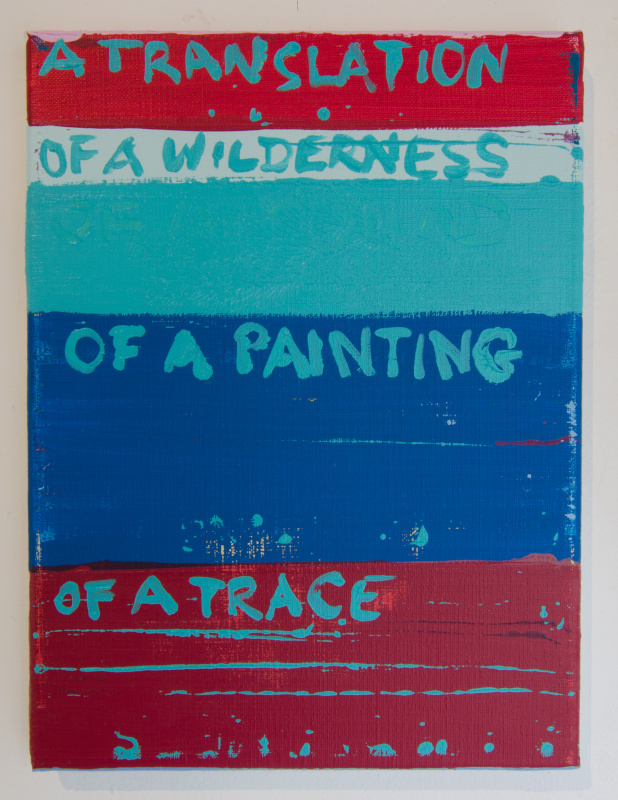
Rendered Imperfectly Rendered, Michael Graeve, 2019. Detail. Photograph by Michael Graeve, copyright.
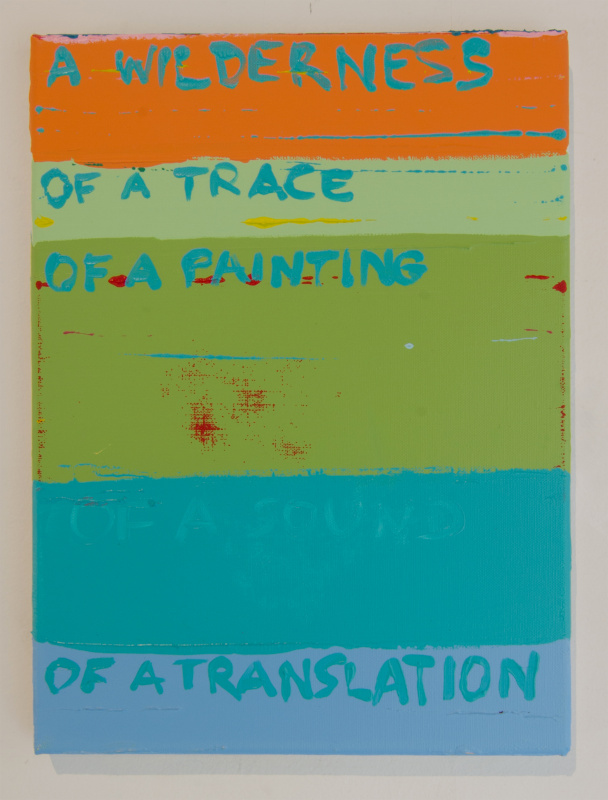
Rendered Imperfectly Rendered, Michael Graeve, 2019. Detail. Photograph by Michael Graeve, copyright.
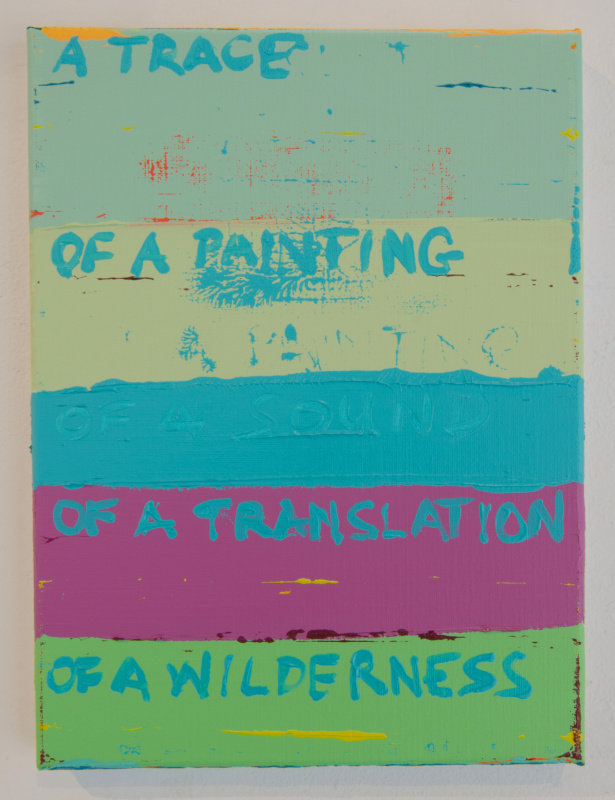
Rendered Imperfectly Rendered, Michael Graeve, 2019. Detail. Photograph by Michael Graeve, copyright.
Works Cited
Cage, John, and Lejaren Hiller / Ben Johnston. HPSCHD / String Quartet No. 2. Nonesuch, 1969. LP.
Cage, John, and Lejaren Hiller. HPSCHD. Electronic Music Foundation, 2003. CD.
---. "HPSCHD." Source, Music of the Avant-Garde, 1966-1973, edited by Larry Austin and Douglas Kahn, U of California P, 2011, pp. 146-160.
Gaburo, Kenneth. Tape Play. Pogus Productions, 2000. CD.
Graeve, Michael. "Rendered Imperfectly Rendered [artists' statement]." Translating Ambiance, curated and edited by Jordan Lacey, 2019, translating-ambiance.com.
Grubbs, David. "Two Shades of Green." The Spectrum Between, Drag City, 2000. CD.
Harper, Ben.. "Wandering Split." Gating, curated by Michael Graeve, West Space, 2002. CD. Versions of this composition are available at http://www.cookylamoo.com/music/slips.shtml [Accessed 18 May, 2020].
Hiller, Lejaren. "An Avalanche For Pitchman, Prima Donna, Player Piano, Percussionist And Pre-Recorded Playback." Avalanche / Nightmare Music / Suite For Two Pianos And Tape / Computer Music For Tape And Percussion, Heliodor, 1970. LP. Available at https://www.youtube.com/watch?v=1PnCLoPdBTU [Accessed 11 June 2020].
Hawley, David. The Ontological Framing of Expanded Abstract Painting within Henri Bergson's Principles of Movement, Duration, Intuition and Becoming, 2018. < eprints.utas.edu.au/30039/ >
Knowles, Alison. Frijoles Canyon. What Next?, 1991. CD.
Lucier, Alvin. Crossings. Lovely Music, 1990. CD.
---. I am Sitting in a Room. Lovely Music, 1990. CD.
Thomas, David. Colour. Time. 2009.
Whitehead, Gregory. "What I Am, And What Not." Shake, Rattle, Roll / Degenerates In Dreamland, V2 Archief, 1995. CD. Excerpts from this track are available on Track 27 from 1'28" at http://www.ubu.com/sound/whitehead.html [Accessed 12 June 2020].
Wittgenstein, Ludwig. Zettel. Edited by G E. M. Anscombe and G H. Wright, U of California P, 2007.
Footnotes
- If the composition and its musical interpretations (1969 and 2003) are already excessively layered, then the premiere performance in 1969 was doubly over the top. An interview tracing the creation of HPSCHD additionally reveals an evocative not-knowing in their transcription process from concept to sound: "[Larry] AUSTIN: John said last night that he hadn't heard a single sound, and you've been working on the piece for ten months" (152). ↩
- My profound gratitude to Warren Burt for vicariously introducing me to all references in this paragraph. Often alternating with Steve Charman, Burt presented Hard Listening on Melbourne Radio 3PBS from 1987 to 1994. I taped a number of Burt's programs, and repeated listens indelibly etched these works into my emerging constellation. ↩
- If Bergson may have "perceived existence to be a composite of experiences and movement" (Hawley 35), then there is a joy in complicating it with a close-to double negative that only approaches affirmation. "A composite consists of things different in kind that are reconciled (not unified) via our experience over time" (Thomas 39). ↩
- I think here of the way in which two voices changing pitch -- one stepped and one continuous -- fall continuously into and out of relation in Alvin Lucier's Crossings (1990). ↩
- Gregory Whitehead's Degenerates In Dreamland (1995) is one such joyful degeneration: it satirically, lovingly, re-performs Alvin Lucier's I am Sitting in a Room (1990). ↩
- Graeve, Michael. .SoundColourinG.ColouringsoundinG. 7-23 Jun. 2019, Lot19, Castlemaine Australia. ↩

